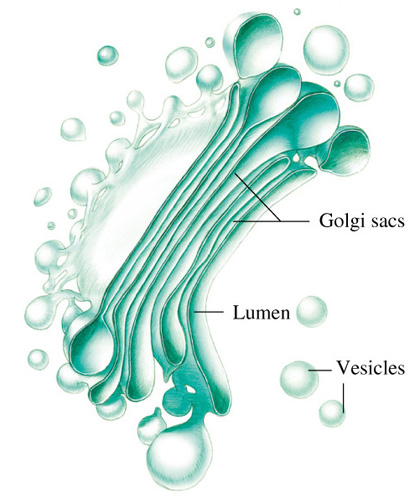

The Golgi apparatus (also called a Golgi body, Golgi complex, or dictyosome) is an organelle found in most eukaryotic cells, including those of plants, animals, and fungi. The name comes from Italian anatomist Camillo Golgi, who identified it in 1898. The primary function of the Golgi apparatus is to process proteins targeted to the plasma membrane, lysosomes or endosomes, and those that will be formed from the cell, and sort them within vesicles. Thus, it functions as a central delivery system for the cell.
Most of the transport vesicles that leave the endoplasmic reticulum (ER), specifically rough ER, are transported to the Golgi apparatus, where they are modified, sorted, and shipped towards their final destination. The Golgi apparatus is present in most eukaryotic cells, but tends to be more prominent where there are a lot of substances, such as proteins, being secreted.
The Golgi apparatus is considered more or less the "post office" of the cell. It handles all incoming lipids, proteins, etc., and controls their export as well.
The transport vesicles from the ER fuse with the cis face of the Golgi apparatus (to the cisternae) and empty their protein content into the Golgi lumen. The proteins are then transported through the medial region towards the trans face and are modified on their way. Possible modifications include glycosylation or phosphorylation. The proteins are also labelled with a sequence of molecules according to their final destination. For example, the Golgi apparatus adds a mannose-6-phosphate label to proteins destined for lysosomes.
The transport mechanism itself is not yet clear; it could happen by cisternae progression (the movement of the apparatus itself, building new cisternae at the cis face and destroying them at the trans face) or by vesicular transport (small vesicles transport the proteins from one cisterna to the next, while the cisternae remain unchanged). It is also proposed that the cisternae are interconnected and the transport of cargo molecules within the Golgi is due to diffusion, while the localisation of Golgi-resident proteins is achieved by an unknown mechanism.
Once the proteins reach the trans face, they are embedded into coated transport vesicles and brought to their final destinations. The form of the vesicle is determined by the type of protein and the label it acquired.
An example of the Golgi complex's functioning is the modification of glycoproteins (used in cell membranes). Vesicles from the ER contain simplified glycosylated proteins. In the Golgi complex, carbohydrates are attached and removed from these glycoproteins, creating a diversity of carbohydrate structures on the proteins. After they have been secreted in to the cell the vesicles fuse to the cell membrane and release their contents.
As well as protein modification, Golgi apparatus is involved in the transport of lipids around the cell as well creating lysosomes, organelles involved in digestion.